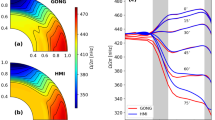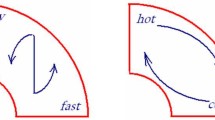Abstract
Observations have consistently pointed out that the longitudinal and latitudinal motions of sunspots are correlated. The magnitude of the covariance was found to increase with latitude, and its sign was found to be positive in the N-hemisphere and negative in the S-hemisphere. This correlation was believed to be due to the underlying turbulence where the sunspot flux tubes are anchored, and the covariance had the right sign and magnitude needed to explain the transfer of angular momentum toward the equator through Reynolds stresses.
Here we present an alternate explanation for these sunspot velocity correlations: It is believed that the dynamo operates in a thin overshoot layer beneath the base of the convection zone, and the flux tubes generated there produce sunspots at the photosphere. By studying the dynamics of flux tubes emerging from the base of the convection zone to the photosphere, we show that these velocity correlations of sunspots could be merely a consequence of the effect of Coriolis force on rising flux tubes. The effect of the Coriolis force, as demonstrated by even a back-of-the-envelope calculation, is to push the faster rotating spots equatorward and the slower rotating spots poleward, giving rise to a correlation in their longitudinal and latitudinal velocities, which is positive in the N-hemisphere and negative in the S-hemisphere. The increase in the correlation with latitude is due to the increase in magnitude of the Coriolis force. Hence we show that these velocity correlations might have nothing to do with the Reynolds stresses of the underlying turbulence.
We present analyses of observations, and show that the covariances of plages are an order of magnitude higher than the sunspot covariances. If plages and sunspots share the same origin, and if their horizontal velocity correlations are wholly due to the effect of Coriolis force on rising flux tubes, then the study of their dynamics suggests that the flux tubes that form plages should have diameters of a couple of thousand km at the base of the convection zone and remain intact until they reach the photosphere, whereas sunspots should be formed by a collection of small flux tubes (each measuring about a hundred km in diameter), that rise through the convection zone as individual elements and coalesce when they emerge through the photosphere.
Similar content being viewed by others
References
Belvedere, G., Godoli, G., Motta, S., Paternò, L., and Zappalà, R. A.: 1976,Solar Phys. 46, 23.
Canuto, V. M., Minotti, F. O., and Schilling, O.: 1994,Astrophys. J. 425, 303.
Chou, D. Y. and Fisher, G. H: 1989,Astrophys. J. 341, 533.
Choudhuri, A. R.: 1989,Solar Phys. 123, 217.
Choudhuri, A. R. and D'Silva, S.: 1990,Astron. Astrophys. 239, 326.
Choudhuri, A. R. and Gilman, P. A.: 1987,Astrophys. J. 316, 788.
Coffey, H. E. and Gilman, P. A.: 1969,Solar Phys. 9, 423.
D'Silva, S.: 1993,Astrophys. J. 407, 385.
D'Silva, S. and Choudhuri, A. R.: 1991,Solar Phys. 136, 201.
D'Silva, S. and Choudhuri, A. R.: 1993,Astron. Astrophys. 272, 621.
D'Silva, S. and Howard, R.: 1993,Solar Phys. 148, 1.
D'Silva, S. and Howard, R.: 1994,Solar Phys. 151, 213.
Durney, B. R.: 1991,Astrophys. J. 378, 378.
Durney, B. R.: 1993,Astrophys. J. 407, 367.
Fan, Y., Fisher, G. H., and DeLuca, E. E.: 1993,Astrophys. J. 405, 390.
Fan, Y., Fisher, G. H., and McClymont, A. N.: 1994,Astrophys. J., in press.
Gilman, P. A.: 1974,Ann. Rev. Astron. Astrophys. 12, 47.
Gilman, P. A. and Howard, R.: 1984,Solar Phys. 93, 171.
Hale, G. E., Ellerman, F., Nicholson, S. B., and Joy, A. H.: 1919,Astrophys. J. 49, 153.
Harvey, K. L.: 1993, Thesis: Magnetic Bipoles on the Sun, University of Utrecht, Ch. 3, p. 61.
Howard, R. F.: 1989,Solar Phys. 123, 271.
Howard, R. F.: 1990,Solar Phys. 126, 299.
Howard, R. F.: 1991a,Solar Phys. 131, 259.
Howard, R. F.: 1991b,Solar Phys. 134, 233.
Howard, R. F.: 1991c,Solar Phys. 135, 43.
Howard, R. F.: 1991d,Solar Phys. 135, 327.
Howard, R. F.: 1992a,Solar Phys. 137, 205.
Howard, R. F.: 1992b,Solar Phys. 142, 47.
Howard, R. F.: 1992c,Solar Phys. 142, 233.
Howard, R. F. and Gilman, P. A.: 1986,Astrophys. J. 307, 389.
Howard, R. F., Gilman, P. A., and Gilman P. I.: 1984,Astrophys. J. 283, 385.
Howard, R. F., Kichatinov, L. L., Bogart, R. S., and Ribes, E.: 1991, in A. N. Cox, W. C. Livingston, and M. S. Matthews (eds.),Solar Interior and Atmosphere, Arizona University Press, p. 748.
Kichatinov, L. L. and Rüdiger, G.: 1993,Astron. Astrophys. 276, 96.
Komm, R. W., Howard, R. F., and Harvey, J. W.: 1994,Solar Phys. 151, 15.
Meyer, F., Schmidt, H. U., Weiss, N. O., and Wilson, P. R.: 1974,Monthly Notices Roy. Astron. Soc. 169, 35.
Moreno-Insertis. F.: 1986,Astron. Astrophys. 166, 291.
Moreno-Insertis, F.: 1992, in J. H. Thomas and N. O. Weiss (eds.),Sunspots: Theory and Observations, Kluwer Academic Publishers, Dordrecht, Holland, p. 385.
Moreno-Insertis, F., Caligari, P., and Schüssler, M.: 1994,Solar Phys. 153, 449.
Nesme-Ribes, E., Ferreira, E. N., and Vince, I.: 1993,Astron. Astrophys. 276, 211.
Parker, E. N.: 1979,Cosmical Magnetic Fields, Clarendon Press, Oxford, Section 8.9.
Parker, E. N.: 1987,Astrophys. J. 312, 868.
Schrijver, C. J.: 1987,Astron. Astrophys. 180, 211.
chüssler, M. Caligari, P., Ferriz-Mas, A., and Moreno-Insertis, F.: 1994,Astron. Astrophys. 281, L69.
Spiegel, E. A. and Weiss, N. O.: 1980,Nature 287, 616.
Spruit, H. C.: 1981,Astron. Astrophys. 98, 155.
Tuominen, I., and Rüdiger, G.: 1989,Astron. Astrophys. 217, 217.
van Driel-Gesztelyi, L. and Petrovay, K.: 1990,Solar Phys. 126, 285.
Wang, Y. M., Nash, A. G., and Sheeley, N. R.: 1989,Astrophys. J. 347, 529.
Ward, F.: 1965,Astrophys. J. 141, 534.
Author information
Authors and Affiliations
Additional information
Operated by the Association of Universities for Research in Astronomy, Inc., under Cooperative Agreement with the National Science Foundation.
Rights and permissions
About this article
Cite this article
D'Silva, S., Howard, R.F. Sunspot velocity correlations: Are they due to Reynolds stresses or to the Coriolis force on rising flux tubes?. Sol Phys 159, 63–88 (1995). https://doi.org/10.1007/BF00733032
Received:
Revised:
Issue Date:
DOI: https://doi.org/10.1007/BF00733032




